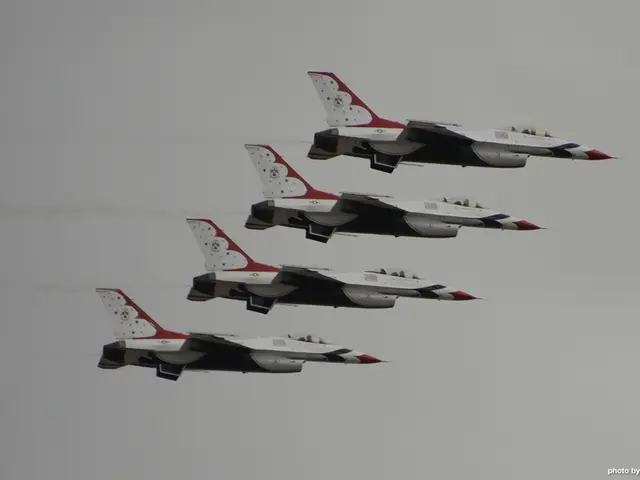F-15EX Fighter Aircraft Dispatched to Japan for Exercises; Kadena Base Gears Up for Incoming Aircraft
Headline: F-15EX Eagle II Fighters Arrive at Kadena Air Base, Enhancing Indo-Pacific Airpower
Kadena Air Base in Japan has seen a significant change in its airpower capabilities with the arrival of two F-15EX Eagle II fighters on July 12, 2025. This marks the beginning of a transition that will see 36 of these advanced jets permanently stationed at the base by spring 2026 [1][2][3].
The F-15EX Eagle II, outfitted with cutting-edge avionics, advanced weapon systems, and expanded offensive and defensive capabilities, will replace the aging F-15C/D Eagles currently based at Kadena. This modernization ensures the base remains well-postured to address the dynamic and evolving security environment in the Indo-Pacific region, particularly given its strategic proximity to Taiwan [2][3].
The arrival of the F-15EXs signifies a key milestone in the Department of Defense's ongoing effort to modernize U.S. airpower in the region. The new jets will significantly enhance Kadena's air dominance by providing greater air-to-air missile capacity and improving offensive and defensive operational flexibility.
Air Force leaders have expressed confidence that the transition to the Eagle II will be smooth, despite shorter deployments to smaller, more dispersed operating locations under the agile combat employment model. The training conducted by the F-15EXs, which began with their arrival, will prepare Kadena personnel for the arrival and future sustainment of the F-15EX in Spring 2026. However, the 18th Wing declined to provide further details on what the training entails [1].
Meanwhile, Misawa Air Base in Japan has begun a transition of its own. In June, it started transferring its F-16s to Osan Air Base in South Korea. Osan is using the F-16s to replace its retiring A-10 Thunderbolt II attack planes. The Air Force plans to rotate a mix of fighters through Misawa during the transition, eventually giving up 36 F-16s for 48 F-35 Lightning II jets [4].
Misawa will be the Air Force's second overseas base to permanently host the F-35 stealth jets, following RAF Lakenheath in England. The Marines have also deployed F-35Bs to Japan at Marine Corps Air Station Iwakuni.
As the Indo-Pacific region continues to evolve, the U.S. Air Force is ensuring it remains a formidable presence through modernization and strategic positioning of its airpower.
Timeline: - July 12, 2025: Initial arrival of two F-15EXs for training and integration. - Spring 2026: Permanent arrival of 36 F-15EX fighters at Kadena Air Base.
Mission impact: - Replaces the aging F-15C/D fleet with more advanced aircraft. - Enhances air dominance through more advanced avionics and weapon systems. - Provides greater air-to-air missile capacity and improved offensive/defensive operational flexibility. - Supports U.S. strategic objectives in the Indo-Pacific, strengthening deterrence and rapid response in a contested environment [1][2][3].
[1] https://www.airforcemag.com/ [2] https://www.defenseone.com/ [3] https://www.usnews.com/ [4] https://www.military.com/
- The space for potential threats in the Indo-Pacific region requires continuous defense, with the newly arrived F-15EX Eagle II aircraft at Kadena Air Base contributing significantly to this security.
- The aerospace industry has played a crucial role in equipping the U.S. Air Force with advanced aircraft like the F-15EX, ensuring its aircraft are outfitted with the latest avionics and weapon systems.
- The air force's hedge against rapidly evolving threats in the Indo-Pacific isn't limited to Kadena Air Base; Misawa Air Base is transitioning its F-16s for 48 F-35 Lightning II jets, aiming to maintain a formidable presence in the region.
- The strategic finance backing these acquisitions and deployments allows the U.S. to sustain and upgrade its air power, ensuring continued industry investment in developing cutting-edge aircraft technologies.
- With the Air Force Space Force's cooperation, these advanced aircraft will be able to effectively coordinate their operational capabilities and enhance joint defense efforts against space-based threats in the Indo-Pacific.








